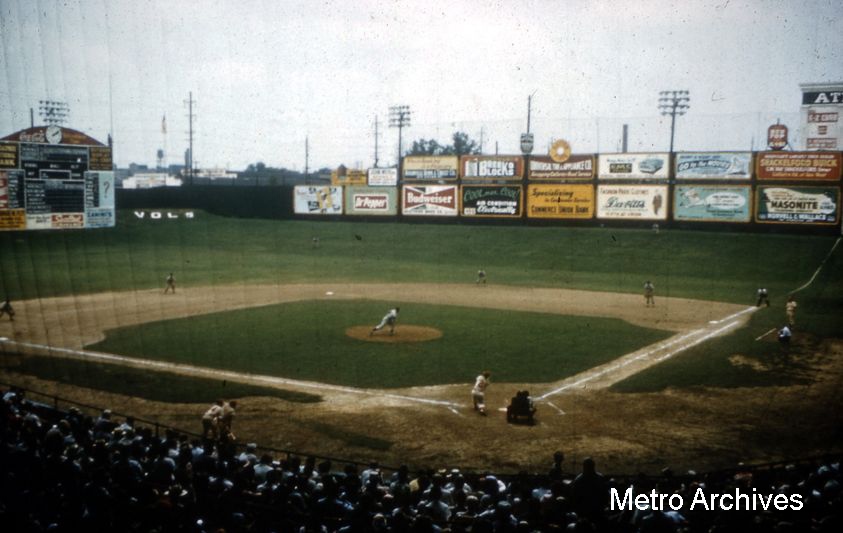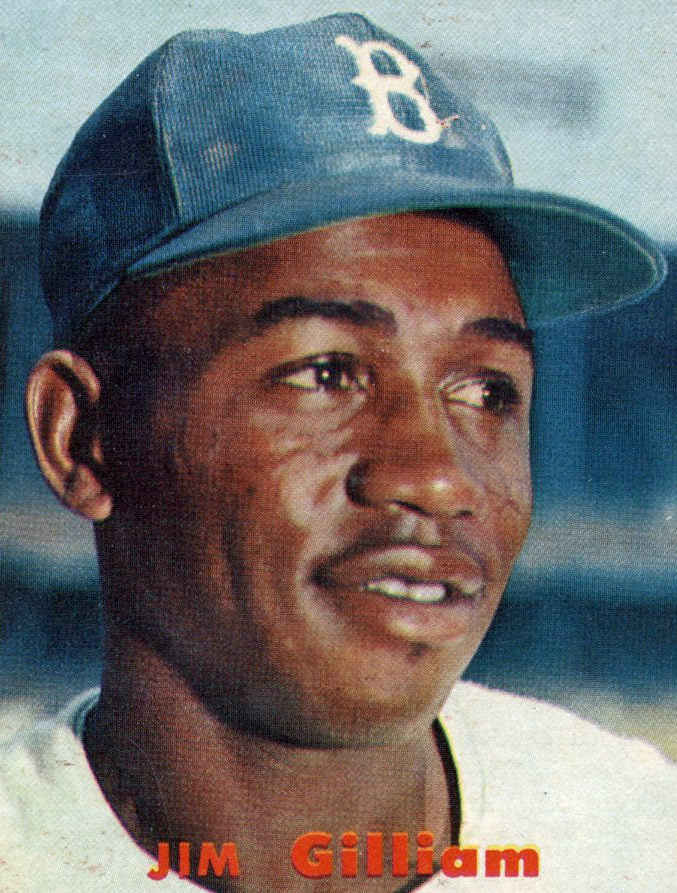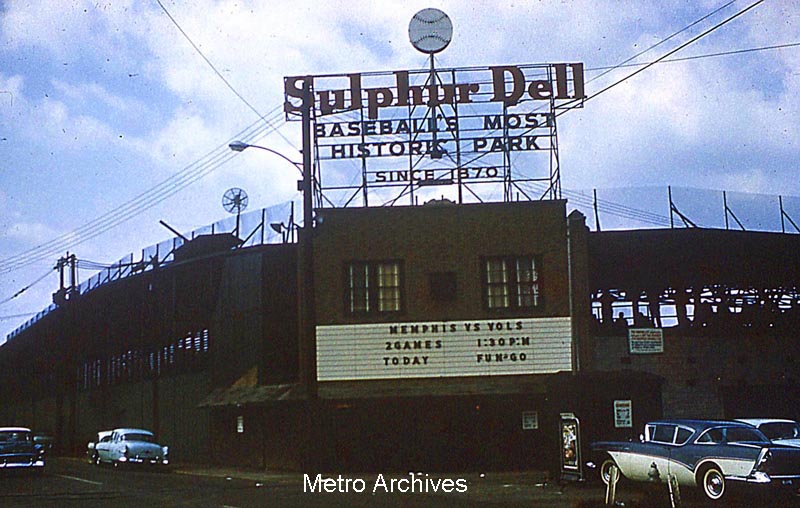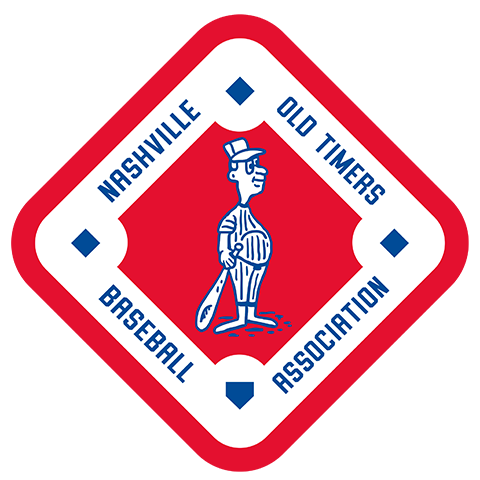
In the mid-19th Century, Nashville’s recreational area was known as “Sulphur Springs Bottom”, so named because a natural sulphur spring was nearby. The area designated for a ball field was bordered by what we know as Fourth Ave., Fifth Ave., and Jackson St. and was referred to as “Athletic Park” as early as 1870.
Nashville’s Early Professional Teams
With the city’s first venture into professional baseball in 1885 a new grandstand was built. The Nashville “Americans” were a member of the inaugural Southern League, and although the league would go in and out of business for the next 15 years, Athletic Park was home field for ball games.
In his sports column published in the Nashville Tennessean on January 14, 1908, Grantland Rice referred to the local ballpark as “Sulphur Spring Dell”, signaling the mark of a new name for the historical site: Sulphur Dell. In later years Nashville Banner sports editor Fred Russell suggested that Rice could not find a word to rhyme with “Sulphur Spring Bottom,” thus the new moniker for Nashville’s baseball home.
New grandstands were constructed for the 1908 season and expanded in 1920. Local amateur and semi-pro teams played at the park when the Nashville Vols of the Southern Association were out of town. These included amateur and semi-pro games; Tom Wilson’s black Nashville Standard Giants used Sulphur Dell, and when renamed the Elite Giants used the famous ballpark as home field until Wilson built his own ballpark.
Batters Faced the Sun
The configuration of Sulphur Dell was such that batters had to face the pitcher and look into the sun. At the end of the 1926 season, it was determined that the ballpark would be turned around so that the afternoon sun would not come into play for hitters.
There was another reason for the reconfigured ballpark: new ownership. On October 1, 1926, four investors took over the Nashville Baseball Club. Rogers Caldwell, a local horse breeder, J. H. “Jack” Whaley, co-publisher of Southern Lumberman, a regional publication, Stanley P. Horn, also co-publisher of Southern Lumberman, and Jimmy Hamilton, manager of the Nashville Vols since 1923.
The first week of December the new owners announced the existing wooden grandstand would be torn down and a new steel & concrete structure would be built – a little unusual, with two of the owners producing a publication about the wood industry in the southeast – and the new ballpark was expected to be one of the best ballpark facilities in baseball for its size. J. B. Hanson Co. was awarded the construction contract. The architect was Marr & Holman.
Ballpark Turned Around in 1927

The “turned around” Sulphur Dell had unusual outfield dimensions due to the shape of the city block in which the ballpark was located. Left field was 334 feet from home plate, the deepest part of the park was at center field at 421 feet, and right field was only 262 feet.
The closeness of the fans to the players was a distinct feature. From first base to the grandstand was forty-two feet, and even closer to the third base at twenty-six feet. But that was not all: the playing surface was below street level and there was an embankment around the entire outfield that was part of the playing field.
The low-lying park was prone to flooding in the spring. Early games were often cancelled, rescheduled, or moved to Vanderbilt so teams could play. With teams having to play on a field that resembled a “drained-out washtub,” players would often mockingly refer to it as “Suffer Hell.”
New Outfield Dimensions
The right field embankment began at 224 feet from home plate, rising at a 45-degree angle towards the fence, ending at 262 feet. The embankment in left field began at 301 feet from home plate.
The outfield fence was made of wood and was sixteen feet high. Running from the right field foul pole to a point 186 feet toward center field, there the fence was capped by a screen that added an additional thirty feet of height but decreased to 22 1/2 feet high midway to center field. In later years, the screen height remained the same, but a second tier of signage was added in right field.
Built to hold 7,500 fans, the construction was barely finished when the team came home to play exhibition games before the beginning of the 1927 regular season.

The first game in the newly-turned-around Sulphur Dell was an exhibition game played against the Minneapolis Millers of the American Association on March 25, 1927. The Millers won 5-3 in a game that lasted two hours and five minutes.
Dick Loftus, right fielder for the Millers, hit the first home run in the new configuration. Blinky Horn, sportswriter for the Nashville Tennessean, referred to right field as the “right center dump” in his account of the game the next day, calling attention to not only the unusual design of the ballpark but acknowledging the smell that the nearby city dump and stock yard offered to the lingering odor in the air.
In the fourth inning of an exhibition game between the Vols and Milwaukee on April 1st, pinch hitter John Black hit a home run to become the first Nashville player to hit one over the fence in the new Sulphur Dell. Horn wrote that the ball “cleared the wall beyond the old Fourth Avenue entrance to the bleachers.”
Southern Association Opening Game Against Atlanta
After additional exhibition games were played, the Nashville Vols returned to Sulphur Dell for the opening game of the 1927 Southern Association against the Atlanta Crackers. With the Vols losing 10-2, Atlanta’s George “Mule” Haas became the first player to hit a home run during the regular season in the new layout, a first inning shot followed by a fourth-inning blast by Walter Gilbert, also of the Crackers. Attendance was announced at 7,535 fans.
The first night game was played at Sulphur Dell on May 18, 1931, as the Vols lost to Mobile 8-1.
On Opening Day on April 12, 1932, attendance was 14,502; with seating capacity of 8,000 in the grandstands the outfield was lined off with rope to accommodate the crowd. It was the largest crowd to see a game at Sulphur Dell. In 1938 seating capacity was increased to 8,500.
“It was a band box,” says Robert “Pat” Burgess, who was scoreboard operator and public address announcer as a teenager in the mid-1940s. “Short right field was what made it tough, with the fence and the screen added to the fence. Some guys had the “Sulphur Dell stroke” an uppercut swing that was needed to slug one out of the park.
“A lot of players didn’t have it, and their careers suffered when playing in parks with normal field dimensions.”
“No matter what we called it, it was our home ballpark and we loved it,” says Gene Smith, a member of the Old Timers Baseball Association and former minor leaguer, “and it had the best pitcher’s mound I ever threw off of.”
Negro League Teams

Sulphur Dell was a favorite ballpark for visiting Negro League teams, drawing large crowds to see the Chicago American Giants, Kansas City Monarchs, Birmingham Black Barons, and New York Black Yankees. It was home to the Nashville Elite Giants, Nashville Black Vols, Nashville Cubs, and Nashville Stars.
Many Black players grew up in Nashville and honed their skills at Sulphur Dell, including Hall of Fame member Turkey Stearnes, Bruce Petway, Dodgers favorite Jim “Junior” Gilliam, Jim Zapp, Sidney Bunch, Jr., and Clinton “Butch” McCord.
Remodeled in 1951
On opening day April 17, 1951, Nashville’s Sulphur Dell celebrated 24 years of service to local citizens with a fresh look that included a remodeled façade, new turnstiles, brick walls, wider exits, and other improvements. Unchanged were the “dumps” in the outfield and the short right field fence.
“Dad would take me to Sulphur Dell two or three times a summer, and we would catch the Vols.” reflects Nashville historian Paul Clements.
“My biggest hero wasn’t a player, it was Larry Munson, who did the play-by-play of Vol games through all those years of my childhood.”
But Sulphur Dell was not just a baseball venue. Concerts by Tex Ritter, Jackie Wilson, and James Brown were held. Dick Clark’s Cavalcade of Stars, Esther Williams’ Water Follies, and the Shrine Circus drew large crowds, and barn-storming baseball exhibitions were held at the memorable ballpark before its demise.
Dwindling Attendence Caused the Demise of Sulphur Dell

When attendance dwindled, attention to the ballpark did, too. The last professional baseball game was played at Sulphur Dell on September 8, 1963, as the Vols of the South Atlantic League faced Lynchburg in a double header. Nashville outfielder Charlie Teuscher belted three home runs as the Vols won over Lynchburg 6-3 and 2-1. Those were the last homers by a professional player at Sulphur Dell.
It was the last hurrah of the famous park. Amateur baseball was played at Sulphur Dell in 1964 and in 1965 it was turned into a speedway. After becoming a tow-in lot for Metro Nashville, Sulphur Dell was demolished on April 16, 1969.
Note: “Sulphur Dell” and “Sulphur Dell Baseball’s Most Historic Park Since 1870” are trademarks by Skip Nipper. All Rights Reserved.
© 2023 by Skip Nipper. All Rights Reserved.



